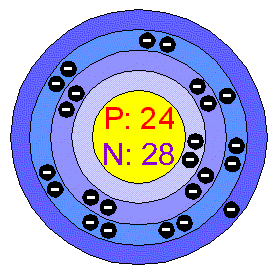

#Chromium atomic number download#
Other big producers include Turkey and India. Download this Free Photo about Chromium chemical element, sign with atomic number and atomic weight, periodic table element, and discover more than 27. About half of all chromite ore is currently produced in southern Africa.The Qin Dynasty of Ancient China used chromium oxide to coat and protect their weapons.Rubies get their red color from small traces of chromium.This name was chosen because the element can form so many different colored compounds.Ĭhromium has four stable isotopes that occur in nature including 50Cr, 52Cr, 53Cr, and 54Cr with the majority of the chromium found in nature being 52Cr. He later isolated the element and gave it its name.Ĭhromium gets its name from the Greek word "chroma" meaning color. Other applications for chromium include wood preservatives, tanning, as catalysts in industrial production, and magnets.Ĭhromium was discovered by French chemist Nicolas L. Many school busses are painted in chrome yellow. One of the most popular colors made from chrome is yellow. It also provides corrosion protection.īecause chromium compounds come in such a variety of colors, it has also been used as a pigment in paints. Chromium is also used to produce superalloys with nickel that are used in jet engines.Īnother popular application for chromium is as a shiny silver coating on metallic surfaces. Stainless steel is strong and resistant to corrosion. One of the most important chromium alloys is produced when chromium is mixed with steel to make stainless steel. The main ore that is mined for the production of chromium is cromite.Ĭhromium is often mixed with other metals to make alloys. It is mostly found in ores scattered throughout the Earth's crust where it is about the twenty-fourth most abundant element. These include chromium(III) oxide (green), lead chromate (yellow), anhydrous chromium(III) chloride (purple), and chromium trioxide (red).Ĭhromium is only found rarely as a free element in nature. It will not react with water.Ĭhromium is known for its many colorful compounds. Chromium can be polished to achieve a shiny mirror-like finish that is resistant to corrosion.įor a metal, chromium is fairly active and will react with many other metals as well as with oxygen. When it is exposed to air a thin layer of chromium oxide forms over the surface which protects the metal from further reaction with the air. Under standard conditions chromium is a hard silvery metal with a bluish tint. Chromium is number twenty-four on the periodic table and located in the same column with molybdenum and tungsten. Chromium atoms have 24 electrons and 24 protons with the most abundant isotope having 28 neutrons. Therefore, there are various non-equivalent definitions of atomic radius.Chromium is the first element in the sixth column of the periodic table. However, this assumes the atom to exhibit a spherical shape, which is only obeyed for atoms in vacuum or free space. The atomic radius of a chemical element is a measure of the distance out to which the electron cloud extends from the nucleus. It must be noted, atoms lack a well-defined outer boundary. The atomic radius of Chromium atom is 139pm (covalent radius).

Note that, each element may contain more isotopes, therefore this resulting atomic mass is calculated from naturally-occuring isotopes and their abundance.

The atomic mass is carried by the atomic nucleus, which occupies only about 10 -12 of the total volume of the atom or less, but it contains all the positive charge and at least 99.95% of the total mass of the atom. The atomic mass or relative isotopic mass refers to the mass of a single particle, and therefore is tied to a certain specific isotope of an element. Mass numbers of typical isotopes of Chromium are 50 52-54. Isotopes are nuclides that have the same atomic number and are therefore the same element, but differ in the number of neutrons. The difference between the neutron number and the atomic number is known as the neutron excess: D = N – Z = A – 2Z.įor stable elements, there is usually a variety of stable isotopes. Neutron number plus atomic number equals atomic mass number: N+Z=A. The total number of neutrons in the nucleus of an atom is called the neutron number of the atom and is given the symbol N. The total electrical charge of the nucleus is therefore +Ze, where e (elementary charge) equals to 1,602 x 10 -19 coulombs. Total number of protons in the nucleus is called the atomic number of the atom and is given the symbol Z. Atomic Number – Protons, Electrons and Neutrons in ChromiumĬhromium is a chemical element with atomic number 24 which means there are 24 protons in its nucleus.


 0 kommentar(er)
0 kommentar(er)
